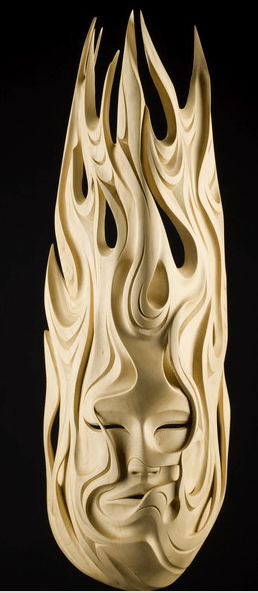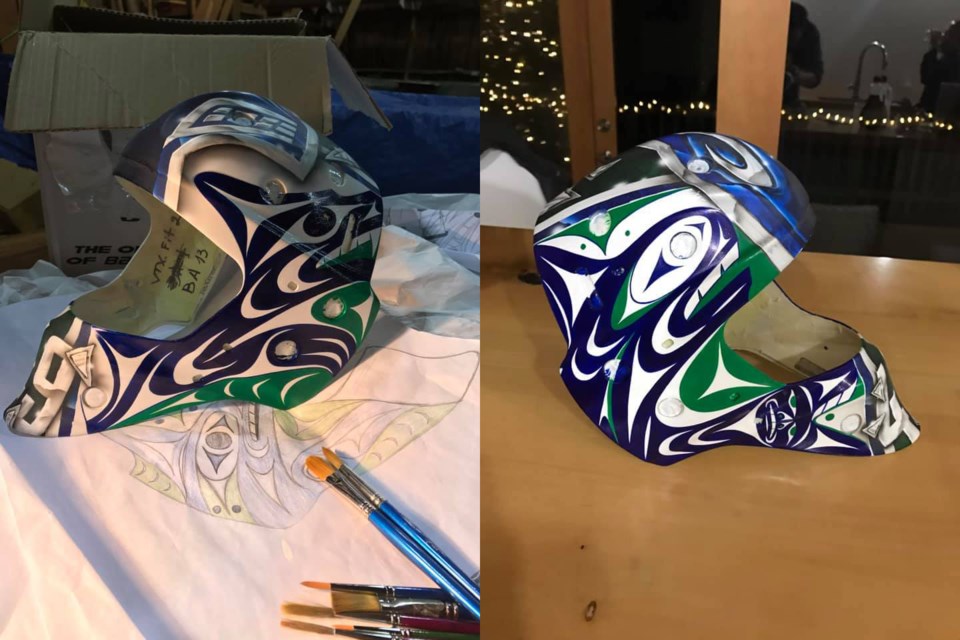When Braden Holtby’s new Canucks mask hit the internet, Luke Marston immediately recognized the Thunderbird design.
“I recognized right away that it was the one that Tony Hunt had replicated in Stanley Park in Vancouver,” said Marston to CBC News. “I was like, ‘Oh no.’ I was excited to see First Nations art on there, I think most people were, but then just the way they executed it wasn’t so cool.”
The Thunderbird on Holtby’s helmet was taken from the famous Thunderbird House Post that was originally designed by Kwakwaka’wakw artist Charlie James and recreated by carver Tony Hunt and placed in Stanley Park. The mask, painted by Swedish artist David Gunnarsson, also incorporated a killer whale design from artist Doug Zilkie.
Marston is a carver from the Stz’uminus First Nation, a Coast Salish People whose traditional territory is on east Vancouver Island. When he saw the controversy sparked by Holtby’s mask, he knew there was an opportunity to turn a negative story into a positive.
He reached out to Francesco Aquilini, who had previously purchased some of Marston’s art, and let him know that he wanted to help.
“I just felt bad for the whole situation. Nobody wants to be targeted by cancel culture and I felt like he had good intentions — they probably both did — they just didn’t know,” said Marston. “I wanted to be a part of it, I knew that I could help them do something cool.”
“With how tragic everything is with COVID and all that negative energy out there, this is something that became really positive really fast,” he added. “We switched the narrative really fast and everybody seemed to be accepting it and excited about it now.”
Marston collaborated directly with Holtby on the new mask, which wasn’t quite ready for either of Holtby’s first two games with the Canucks.
“I got ahold of Braden and we talked for awhile and he started off the conversation, he felt really bad about the whole thing,” said Marston. “He was telling me that David Gunnarsson, who did the mask from Sweden...he felt really bad too, so it just evolved into a collaboration from there.”
On the hunt
Marston shared stories to spark ideas and when he told Holtby a legend about killer whales that could transform into wolves and hunt on both land and in the ocean, that caught the attention of the Canucks goaltender.
“He really liked that and it’s kind of a fit for the Canucks being on the hunt this year,” said Marston.
There are numerous legends across Pacific Northwest First Nations connecting wolves and killer whales, who are called sea wolves by some nations. In some traditions, it was a wolf entering the sea that became the first killer whale. In other stories, killer whales have the supernatural ability to transform back and forth between wolf and whale forms.
In Marston’s design for Holtby’s helmet, the killer whale is on one cheek and the wolf in mid-transformation on the other. The top of the mask depicting the Canucks logo and the chin with Holtby’s number were designed by Gunnarsson in Sweden and the mask was returned to Gunnarsson for the finishing touches.
“We were trying to get it for the first game, but it got hung up in transport,” said Marston. “I ended up sending it to Sweden and David Gunnarsson clear-coated it, finished it all up, then he sent it to Bauer. Bauer puts all the padding and straps and everything on it, then they send it to the Canucks.”
Marston's masks
While this was Marston’s first goalie mask, it’s far from the first mask he has designed. In Pacific Northwest First Nations cultures, masks are carved for decorative purposes, but also for important ceremonial use, and Marston has carved many masks in his career.
In fact, one of his masks, carved over a decade ago, has the same theme as his design for Holtby’s mask: wolves transforming into killer whales.
While Marston has primarily worked with wood, he has also done many bronze sculptures, as well as stone carving, painting, and jewelry. Holtby's mask represented a brand new material to work with, however.
"Working on plastic was a little bit different, that's not really something that I've worked before," he said. "[The goalie mask] lends its shape well to our art form. I think First Nations art can be adapted really to anything. With the mask culture that we do and all the masks that we carve, it lends itself really easily to the art form."
Marston's most striking mask is his piece titled “First Woman,” which depicts a woman’s face seemingly engulfed in flames, undergoing some sort of transformation of her own. Regrettably, the towering flames probably wouldn't be allowed on a goalie mask.
 "First Woman" by Luke Marston. By Inuit Gallery of Vancouver
"First Woman" by Luke Marston. By Inuit Gallery of VancouverIt’s unclear when Holtby’s new mask will arrive, but with Thatcher Demko getting the start Monday night, it won’t get its debut until Wednesday’s home opener against the Montreal Canadiens at the earliest.




